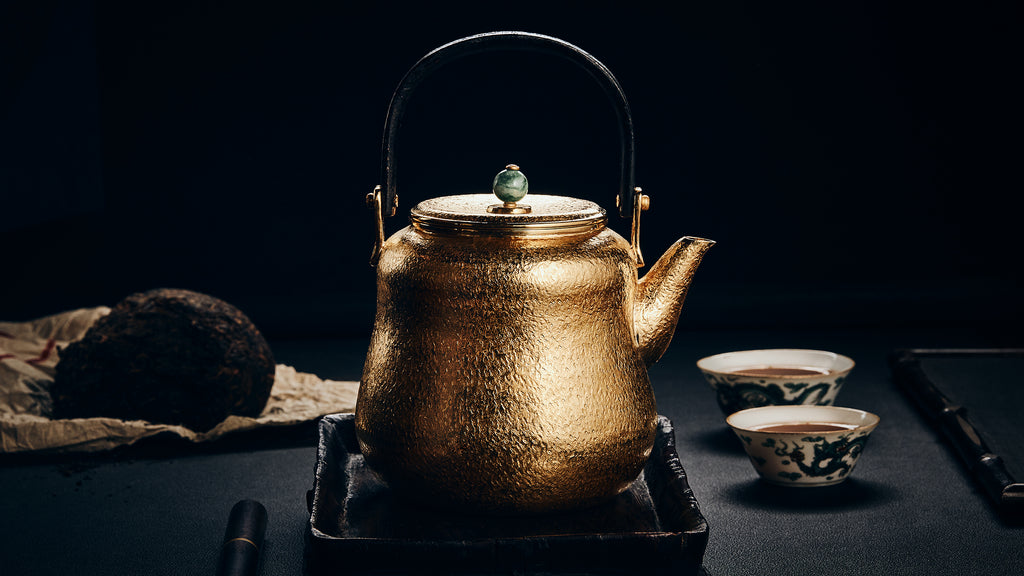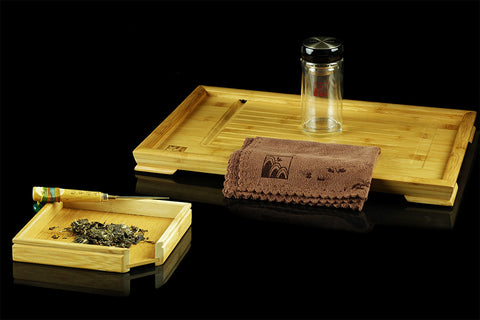- What is Pu-erh Tea?
Pu-erh tea is a variety of tea made in the Lancang River region in the southern and western parts of Yunnan province. It uses large, fresh leaves from tea trees (camellia sinensis assamica), and is sun-dried and typically compressed to cake and bricks and can be stored for a long time.

Pu-erh tea has two categories: Raw Pu-erh, and Ripe Pu-erh.
Both types are made from the same sort of tea trees. Raw Pu-erh is made from sun dried large tea leaves and pressed into cakes, tuocha, and bricks. It ages slowly and naturally within time. Ripe Pu-erh is made from sun dried large tea leaves, and goes through fermentation and then pressed to different shapes. Raw Pu-erh’s tea leaf is dark green and its tea water is bright yellow-orange. Ripe Pu-erh's tea leaves are dark brown with bright maroon tea water that resembles the color of red wine.
- How do I brew Pu-erh tea?
To learn the traditional method for brewing Pu-erh tea, read our instructional guide or watch this instructional video:
To learn how to brew tea using our double-walled Glass Tumbler, check out this instructional video:
- Why does Pu-erh tea sometimes come in cakes and bricks?
This method of storing tea is centuries old and was originally developed as a means to more efficiently transport the tea and preserve its aroma. We still press our tea into these shapes both to honor tradition and to preserve the tea aroma. In addition, Pu-erh tea is great for collection and investment, and keeping the tea pressed into cakes and bricks ensures that the value of the tea will increase over time.
- I bought a compressed tea cake or tea brick. What now?
After you’ve purchased a tea cake or brick, the choice is then whether to enjoy it now or save it for later. If you choose to save it for later, see below. If you’d like to drink the tea now, use a Pu-erh pick or knife to break apart the tea cake or brick.
To learn how to use a Pu-erh pick, read our instructions or watch this instructional video:
- What teaware should I use?
For the most part, this depends on your situation and desired result. If your aim is to simply brew a great pot of tea, a Yixing clay teapot generally yields the best quality tea. In more formal settings, such as a tea ceremony, a Gaiwan (a covered bowl) allows the brewer and the audience to experience the process in a traditional way. When it is more casual, consider using our Glass Tumbler for a more convenient brewing experience.
If you're having trouble figuring out what you need to get started, take a look at our starter set, pictured below.

- How should I store Pu-erh Tea?
It depends! If you’re storing pressed Pu-erh tea, leave it in the package, allowing it to retain its freshness. If it’s loose tea, we recommend storing it in a tea jar. Either way, the tea should be kept at room temperature in a dry, well-ventilated place. You should also refrain from exposing it to direct sunlight or any foreign odors. Finally, make sure to keep your raw and ripe Pu-erh tea stored separately.
- What is máo chá?
Máo chá, translated as “rough,” is the name for the raw tea product before it has been treated, or compressed.
- What should I keep in mind when purchasing Pu-erh tea?
There are four standards to keep in mind when purchasing Pu-erh tea: smell, color, storage, and flavor. Many tea shops invite you to sit and taste the tea with them, so this inspection is easy and convenient.
- Smell: the tea shouldn't any strange or unexpected aromas.
- Color: observe its color to check for a yellow-green color for raw tea, and a reddish, maroon color for ripe tea.
- Storage: it should be stored in a dry and clean environment.
- Flavor: it should have a mild aroma without any additional flavors mixed in.
- What should I avoid when buying Pu-erh tea?
- Don’t be fooled by incorrect label dates when judging tea.
- Don’t rely on the packaging for judging the quality of the tea, as it can be faked.
- Don’t judge the tea’s age based on its dark color.
- Don’t mistake any added flavors for the tea’s original flavor.
- Don’t use the tea tree age as the only measurement for quality.
- What’s the difference between dry and wet storage?
Dry storage refers to a method of storing Pu-erh tea in a warehouse with a humidity level below 80% to allow a slow, natural aging process. Wet storage refers to the method of storing Pu-erh tea in a warehouse with a humidity level above 80% to accelerate its fermentation.
However, expediency comes at a cost; often, Pu-erh tea will develop a musty odor in wet storage or even grow mold. Dry storage helps the tea maintain its natural aroma, and is generally a safer and healthier method of storing Pu-erh tea.
Keep in mind that some companies will take Pu-erh tea that’s held in wet storage and try to pass it off as dry storage Pu-erh tea, so always closely inspect the Pu-erh you’re about to purchase.
- What’s the difference between sun-dried and high-heat dried tea?
The high-heat dried tea is made from fresh tea leaves that get processed through a dryer at high temperatures. Although it gains a strong aroma through this process, it also gains an expiration date and cannot be stored for a long time.
As its name suggests, sun-dried máo chá refers to tea leaves that are left out in the sun to dry naturally. The resulting product can then be stored for a long time. Practically speaking, Pu-erh tea is made by sun drying the tea leaves, instead of being dried by machine.
- What are crab legs?
Pang Xie Jiao, or crab legs, are parasitic plants that can grow on old arbor tea trees. They are green in color and are shaped like crab pincers. Even though the plant is considered a parasite, it has a strong, pleasant plum smell and contains various nutrients that are medicinal and can be used to treat stomachaches and diabetes.
- How is Pu-erh tea ranked?
Pu-erh tea is divided into high, medium, and low ranks. High-rank loose tea can be divided into “tribute tea,” “ceremony tea,” and specialized tea.
A tea’s rank is determined by the number of buds or stems it has. A higher ranked tea has more buds, while a lower ranked tea has more stems. These ranks don’t always correlate with quality, however. Although a higher ranked tea is more tender and contains more buds, this doesn’t mean that it is objectively better.
